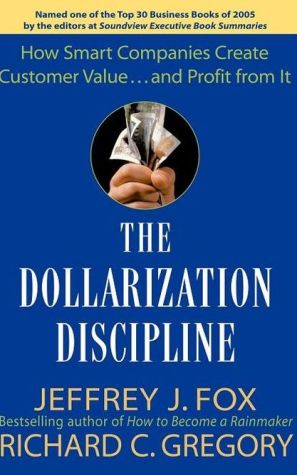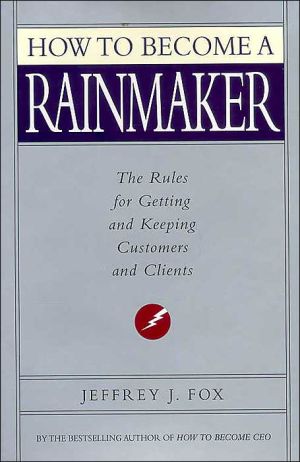Dollarization Discipline: How Smart Companies Create Customer Value... and Profit from It
"GE people realize that our job is to help our customers make money. Dollarization thinking helps us do that."\ Damian A. Thomas, General Manager and Corporate Sales Leader General Electric Company\ "THE DOLLARIZATION DISCIPLINE demystifies the often misused term ‘value,’ and shows how to become a thought partner and sell the true worth of your offering. This book will pay for itself many times over."\ Anthony Parinello, Author, Selling to Vito and Getting the Second Appointment\ "Strategic...
Search in google:
"GE people realize that our job is to help our customers make money. Dollarization thinking helps us do that." –Damian A. Thomas, General Manager and Corporate Sales Leader General Electric Company "THE DOLLARIZATION DISCIPLINE demystifies the often misused term ‘value,’ and shows how to become a thought partner and sell the true worth of your offering. This book will pay for itself many times over." –Anthony Parinello, Author, Selling to Vito and Getting the Second Appointment "Strategic marketing begins with an understanding of how a business creates economic value for its customers. This is a core focus for PPG businesses, and THE DOLLARIZATION DISCIPLINE creatively demonstrates how this thinking can be applied to all aspects of sales and marketing." –Dennis A. Kovalsky, Vice President, Automotive Coatings PPG Industries "Read this book and do what it says. Your customers, and your employer, will thank you for it." –John Chickosky, Vice President, FTS Systems "A must-read for any business looking to improve sales growth, profitability, and customer retention." –Dean Graham, Managing Director, CapitalSource Inc. "THE DOLLARIZATION DISCIPLINE presents powerful concepts with practical implementation ideas. Businesses large and small will benefit from putting Dollarization to work." –John Vander Vort, Director, Private Markets Group DuPont Capital Management Jeffrey Fox introduced the concept of Dollarization in his bestselling books How to Become a Rainmaker and How to Become a Marketing Superstar. Now, he and Rick Gregory present this compelling,effective principle in full detail so you can apply it to your business. The Dollarization Discipline shows organizations how to effectively communicate the economic value created by their products and services. Every day, good companies suffer because they create financial value for customers but aren’t able to keep their fair share. This is because most marketers cannot fully articulate the value customers get from their products, and the argument falls to the lowest common denominator–price. The solution is an approach to sales and marketing that goes beyond articulating features and benefits, but calculates the monetary gain a customer receives in exchange for the price paid. This book offers step-by-step strategies for doing just that. Dollarization is simple in theory but complicated in practice. Authors Fox and Gregory include helpful charts, how-to steps, and dozens of real-life examples featuring leading companies that illustrate important techniques and help you shape an effective marketing and selling strategy. This book offers strategies and techniques that will interest CEOs, marketing VPs, field salespeople, and everyone in between. Salespeople will learn how to handle price objections, shorten sales cycles, protect business from competition, get appointments, and more. Marketing professionals will learn to apply Dollarization to new product pricing, market segmentation, even advertising and communications. Successful companies prosper by discovering how their customers make money and then aligning resources to help those customers make more money. Dollarization is a core discipline that enables firms to put this strategy into practice. With this book, Fox and Gregory include the step-by-step guidance you need to make Dollarization the foundation of your business strategy. If you believe your company is under-compensated for the real value it delivers to customers, this book will help. Packed with practical advice and real-world wisdom, The Dollarization Discipline presents all the tools and techniques businesses need to turn their value-added into real money. Soundview Executive Book Summaries At the heart of The Dollarization Discipline lies the concept of understanding the financial impacts a product or service has on its buyer. Although this involves the idea of "total cost of ownership," it focuses on more than just cost reduction and cost avoidance. In The Dollarization Discipline, marketing guru Jeffrey J. Fox and management consultant Richard C. Gregory describe how organizations can also measure the financial impact of noncost benefits, including increased market share, increased sales volume, and increased pricing power.Getting Started With Dollarization You are shopping for paint and find many choices at the local paint store. Product X costs $12 a gallon; product Y costs $20 a gallon. Which paint should you buy? The salesperson says, "I strongly recommend product Y. Its price may be higher, but it will last eight years, while the other paint will last four at best. That means that over eight years, you'd have to buy product X twice, for a total of $24 a gallon, versus just $20 a gallon for product Y. In reality, product Y costs less!" You reply, "That's very interesting, but I'm preparing to sell my home, so I don't care about how long this paint will last. I think I'll go with product X for $12." The salesperson listens and responds, "I understand, but I think product Y is still your best choice. You see, product Y contains 50 percent more pigment, which results in better coverage than product X. This means you will need to apply only one coat to your house. Product X will require at least two coats. This will also cut your labor costs in half. Plus, you are guaranteed that your house will look freshly painted, which will improve your success in selling your home. Wouldn't you agree that an extra $8 per gallon is a great investment to sell your house at the price you want?" Finally, you decide. The $20 paint is actually less expensive than the $12 paint. Financial Consequences of Choosing When businesses make purchases, too often they are myopic and overemphasize the importance of price. They overlook the many other financial consequences of choosing one offering over another. This is a failure on the buyer's part, because it may very well result in financial harm to the organization. But more importantly, it is a failure on the seller's part because the seller has missed the chance to demonstrate the true financial impact that could be provided to the customer. The meaningful way to compare the cost of two offerings is by evaluating the total cost of using each. In order to help customers to understand the true net cost of your product, you must dollarize the product's true value. Dollarization is figuring out what your offering is really worth - in dollars and cents - to your customer. It is the management discipline that is missing in many sales and marketing organizations, and its impact can be great, and its applications are many. Dollarization can help your company better understand, articulate and profit from the value you create for your customers and clients. Dollarization should become a standing discipline that guides your thinking about pricing, selling, positioning, new product development, and nearly every other area of your sales and marketing. Value Is a Number In sales and marketing, value takes the form of value-added, value chain, value proposition, or value engineering. When sales and marketing people talk value, they use words - words that lack precision - and rarely use numbers. The solution is an approach to sales and marketing that goes beyond articulating features and benefits, but in fact calculates the full economic value a customer receives from a product or service; the seller is then able to price the product or service as a true reflection of that value. This approach is called dollarization. Businesses do not buy; they invest. Every time a company makes a purchase decision, it is committing company capital. In theory, that capital is constantly being allocated and reallocated to achieve the best available return. Too few companies exercise this discipline for all purchases. And far fewer companies market and sell in a way that permits customers to understand the economic value provided in return for the investment. Whatever you do, you must map exactly how your offering translates to value for your customer's business. Copyright © 2005 Soundview Executive Book Summaries
Ch. 1Getting started with dollarization3Ch. 2Value is a number9Ch. 3Why dollarize?19Ch. 4After the bubble burst27Ch. 5Dollarization and selling your price43Ch. 6Dollarization and selling something new63Ch. 7Shortening the sales cycle75Ch. 8Dollarization to protect and keep business83Ch. 9Removing doubt in the seller's mind93Ch. 10Dollarization to get a prospect's attention97Ch. 11Dollarization and channel partners105Ch. 12Dollarizing and selling services113Ch. 13Dollarization and marketing communications123Ch. 14Pricing new products143Ch. 15Dollarization and market segmentation159Ch. 16Dollarization in consumer marketing167Ch. 17Dollarization and the commodity myth175Ch. 18Dollarization and new product direction187Ch. 19The mechanics of dollarization197Ch. 20How to dollarize any benefit203Ch. 21Developing dollarization data211Ch. 22Making dollarization work with the customer225Ch. 23Constructing the customer value file241AppThe dollarization doctrine : ten rules to successful dollarization249
\ Soundview Executive Book SummariesAt the heart of The Dollarization Discipline lies the concept of understanding the financial impacts a product or service has on its buyer. Although this involves the idea of "total cost of ownership," it focuses on more than just cost reduction and cost avoidance. In The Dollarization Discipline, marketing guru Jeffrey J. Fox and management consultant Richard C. Gregory describe how organizations can also measure the financial impact of noncost benefits, including increased market share, increased sales volume, and increased pricing power.\ Getting Started With Dollarization\ You are shopping for paint and find many choices at the local paint store. Product X costs $12 a gallon; product Y costs $20 a gallon. Which paint should you buy?\ The salesperson says, "I strongly recommend product Y. Its price may be higher, but it will last eight years, while the other paint will last four at best. That means that over eight years, you'd have to buy product X twice, for a total of $24 a gallon, versus just $20 a gallon for product Y. In reality, product Y costs less!"\ You reply, "That's very interesting, but I'm preparing to sell my home, so I don't care about how long this paint will last. I think I'll go with product X for $12."\ The salesperson listens and responds, "I understand, but I think product Y is still your best choice. You see, product Y contains 50 percent more pigment, which results in better coverage than product X. This means you will need to apply only one coat to your house. Product X will require at least two coats. This will also cut your labor costs in half. Plus, you are guaranteed that your house will look freshly painted, which will improve your success in selling your home. Wouldn't you agree that an extra $8 per gallon is a great investment to sell your house at the price you want?"\ Finally, you decide. The $20 paint is actually less expensive than the $12 paint.\ Financial Consequences of Choosing\ When businesses make purchases, too often they are myopic and overemphasize the importance of price. They overlook the many other financial consequences of choosing one offering over another. This is a failure on the buyer's part, because it may very well result in financial harm to the organization. But more importantly, it is a failure on the seller's part because the seller has missed the chance to demonstrate the true financial impact that could be provided to the customer.\ The meaningful way to compare the cost of two offerings is by evaluating the total cost of using each. In order to help customers to understand the true net cost of your product, you must dollarize the product's true value.\ Dollarization is figuring out what your offering is really worth - in dollars and cents - to your customer. It is the management discipline that is missing in many sales and marketing organizations, and its impact can be great, and its applications are many. Dollarization can help your company better understand, articulate and profit from the value you create for your customers and clients. Dollarization should become a standing discipline that guides your thinking about pricing, selling, positioning, new product development, and nearly every other area of your sales and marketing.\ Value Is a Number\ In sales and marketing, value takes the form of value-added, value chain, value proposition, or value engineering. When sales and marketing people talk value, they use words - words that lack precision - and rarely use numbers.\ The solution is an approach to sales and marketing that goes beyond articulating features and benefits, but in fact calculates the full economic value a customer receives from a product or service; the seller is then able to price the product or service as a true reflection of that value. This approach is called dollarization.\ Businesses do not buy; they invest. Every time a company makes a purchase decision, it is committing company capital. In theory, that capital is constantly being allocated and reallocated to achieve the best available return. Too few companies exercise this discipline for all purchases. And far fewer companies market and sell in a way that permits customers to understand the economic value provided in return for the investment. Whatever you do, you must map exactly how your offering translates to value for your customer's business. Copyright © 2005 Soundview Executive Book Summaries\ \ \








